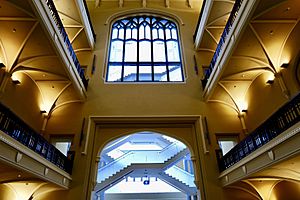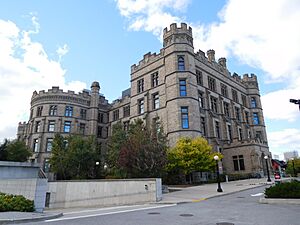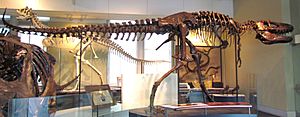Canadian Museum of Nature facts for kids
| Musée canadien de la nature | |

Exterior of the Victoria Memorial Museum Building
|
|
| Established | 1856 |
|---|---|
| Location | 240 McLeod Street, Ottawa, Ontario, Canada
1740 Chemin Pink, Gatineau, Quebec, Canada |
| Type | Natural history museum |
| Visitors | 461,797 (FY2018–19) |
The Canadian Museum of Nature (also known as the CMN) is a special museum in Canada. It focuses on the natural world, like animals, plants, rocks, and fossils. The museum has two main locations. Its exciting exhibits and public events are in the Victoria Memorial Museum Building in Ottawa, Ontario. The museum's offices and science labs are in a different building, the Natural Heritage Campus, in Gatineau, Quebec.
This museum started a long time ago, in 1856. It was part of the Geological Survey of Canada, which studied rocks and land. It began in Montreal and later moved to Ottawa in 1881. In 1911, it moved into the Victoria Memorial Museum Building. Over the years, the museum grew and changed names. It became the National Museum of Canada in 1927, adding human history to its collections. Later, in 1968, the natural history part became its own museum, called the National Museum of Natural Sciences. In 1990, it got its current name, the Canadian Museum of Nature. This happened when it became an independent organization, called a crown corporation, which is owned by the government but runs itself. Between 2004 and 2010, the museum's main building in Ottawa was updated and made bigger.
Today, the museum has a huge collection of over 14.6 million natural items. Many of these are on display in its permanent exhibits. The museum also creates and hosts special exhibits that travel to other places. Plus, its scientists do important research about nature.
Contents
History of the Museum
How the Museum Started (1856–1968)
The Canadian Museum of Nature began with the Geological Survey of Canada (GSC). This group was formed in 1842 in Montreal to explore Canada's geology. In 1856, a law was passed that allowed the GSC to open a museum. This museum would show off items found during their trips, like rocks and old tools.
In 1877, the museum's job grew. It started to include studying modern animals and plants, as well as human history and languages.
In 1881, the museum moved from Montreal to downtown Ottawa. But the new building soon became too small. By 1896, people were asking the government to build a bigger museum. Plans for a new building were made by 1899, and construction started in 1906. In 1907, the museum's management changed, and its job officially included studying people and cultures. The new building, called the Victoria Memorial Building, was finished in 1910. It opened to the public in 1912. In 1927, the museum part of the government department was renamed the National Museum of Canada. It officially became separate from the GSC.
In 1950, the National Museum was moved to a different government department. In 1956, it was split into two main parts: one for natural history and one for human history. The museum's role expanded again in 1958 when it took over the Canadian War Museum. A history section was also added in 1964.
The Natural History Museum Today (1968–Present)
In 1968, the different parts of the National Museum of Canada became separate museums. The Canadian Museum of Nature came from the natural history part. It was first called the National Museum of Natural Sciences. The human history part became the National Museum of Man (now the Canadian Museum of History). The science and technology part became the National Museum of Science and Technology (now the Canada Science and Technology Museum).
In 1990, the Canadian government passed a law called the Museums Act. This law made the National Museum of Natural Sciences and other national museums independent. The same law also changed the museum's name to the Canadian Museum of Nature. By 1990, the museum was the only group left in the Victoria Memorial Building. In 1997, the museum opened a new building in Gatineau, Quebec. This building brought together its research labs and collections in one place.
Between 2004 and 2010, the government spent about C$216 million to expand and renovate the Canadian Museum of Nature. Big parts of the old building were removed and rebuilt. On May 22, 2010, which is International Day for Biological Diversity, the museum building reopened to the public. The building's new glass tower, called the Queens' Lantern, was named in honor of Queens Victoria and Elizabeth II. Queen Elizabeth II even attended the dedication ceremony in June 2010.
Museum Locations
The Canadian Museum of Nature has two main locations. The Victoria Memorial Museum Building in Ottawa is where you can see the museum's exhibits and public programs. Its offices, research labs, and collection storage are at the Natural Heritage Centre in Gatineau.
Victoria Memorial Museum Building
The Victoria Memorial Museum Building in Ottawa is home to the museum's exciting exhibits and other public events. This building is on a 3.6-hectare (9-acre) property in Centretown, a neighborhood in Ottawa. It's about 1.6 kilometers (1 mile) south of Centre Block on Parliament Hill. The building was designed to look like the Canadian Parliament Buildings.
This building was the first museum building ever built specifically for a museum in Canada. The government approved its construction in 1901 to honor Queen Victoria. It was built between 1905 and 1911. After it was finished, it housed the national museums and even the National Gallery of Canada from 1911 to 1959. The building's theater also hosted the Ottawa Little Theatre until 1916. The theater group had to leave when a fire damaged Centre Block, forcing the parliament to use the museum building temporarily until 1920. The Canadian Museum of Nature became the only group in the building after the Canadian Museum of Civilization moved out in 1988. On February 23, 1990, the building was named a National Historic Site of Canada. This was because it was important for how museums developed in Canada and for its unique architecture.
Building Design
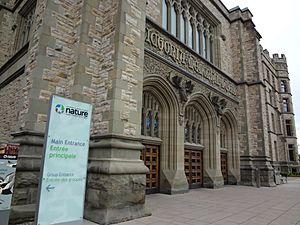
The 203492-square-foot (18910 m2) building has a mix of Tudor and Gothic Revival styles. It was designed by David Ewart, the main architect for the government. You can see Tudor-Gothic details all over the building. This includes its original entrance with three arches, pointed windows, decorative supports, and castle-like tops. Many carvings on the building show Canadian plants and animals. The building's design also uses ideas from Beaux-Arts architecture.
Inside, the building is decorated with carved wood, bronze railings, mosaic floors, marble, and stained glass windows. The main areas are built around a large hall. From this hall, you can reach all other parts of the museum.
The building originally had a tall tower at its entrance. However, this tower caused the building to "sink" because the original design didn't account for the soft Leda clay it was built on. So, the original tower was removed a few years after the building opened. A new glass and steel tower was built in its place between 2004 and 2010. This new central tower, called the Queens' Lantern, officially opened in May 2010. The 20-meter (66-foot) glass tower has a special staircase that helps visitors move around the museum better.
Building the Queens' Lantern was part of a bigger renovation project from 2004 to 2010. This project also added a 25,000-square-foot (2300 m2) expansion to the south of the building. This new area included labs, a shipping area, workshops, and a green roof. The green roof is a public outdoor space. The area around this expansion has green spaces, a greenhouse, and a live animal display. Other renovations included updating the exhibits, making the building safer for earthquakes, improving electrical systems, removing asbestos, and fixing the stone walls.
The building was made using Tyndall stone, steel frames, concrete, and sandstone. Most of the sandstone came from Nepean, Ontario, Wallace, Nova Scotia, and parts of Quebec. The granite used came from Stanstead, Quebec.
Natural Heritage Campus
The Natural Heritage Campus is where the museum's offices, science labs, and collection storage are located. This 76-hectare (188-acre) campus in Gatineau, Quebec, opened in 1997. The building itself is 20478 square meters (220420 sq ft) and has workspaces and lab areas.
The building has three special "pods" that control the environment. These pods hold 42 individual collection rooms and nine documentation rooms. More than 3,000 cabinets are used to store the museum's specimens. To keep the specimens safe, none of the storage rooms share a wall with the outside of the building. A special sealed hallway surrounds these storage spaces.
Museum Exhibitions
The museum has seven permanent exhibitions at its Victoria Memorial Museum Building. Besides these, the museum also hosts and creates several travelling exhibitions that visit other places.
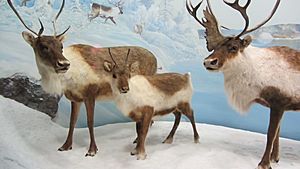
Here are some of the permanent exhibitions:
- The Bird Gallery has over 500 bird specimens on display, representing more than 450 different species.
- The Mammal Gallery focuses on mammals found in Canada. It includes several detailed scenes painted by Clarence Tillenius.
- The Earth Gallery is about minerals, rocks, and how the Earth changes. It even has a piece of moon rock given to Canada by the United States.
- The Fossil Gallery shows fossils of dinosaurs, mammals, and sea animals from 35 to 85 million years ago. It has over 30 almost complete dinosaur skeletons. A very complete Edmontosaurus skeleton in this gallery was the first dinosaur skeleton ever put on display in a Canadian museum. It was acquired in 1912 and has been on display since 1913.
- Nature Live is a gallery with live spiders, insects, and other small creatures.
- The Water Gallery focuses on marine animals and how water works.

The newest permanent exhibition is the Canada Goose Arctic Experience. It has over 200 items and artifacts from the Canadian Arctic. This gallery opened in June 2017, as part of Canada's 150th birthday celebrations. The Arctic Experience gallery is 8000 square feet (740 m2) and is divided into four areas: climate, ecosystems, geography, and sustainability. It also has a Beyond Ice display that gives visitors a sensory experience of the Arctic. Some items in this gallery, like a seal-skin kayak and items from John Franklin's lost expedition, were loaned by the Government of Nunavut.
Museum Collections
Collecting items is a main goal of the Canadian Museum of Nature. The collection helps people learn about and appreciate the natural world. The museum's collection includes algae, amphibians, birds, fish, gemstones, insects, mammals, minerals, plants, reptiles, rocks, and fossils. It also has natural history art, animal sound recordings, and animal models used in exhibits.
As of February 2017, the museum's collection has over 14.6 million specimens. This is the largest collection of biological specimens in Canada! While some items are on display, many are kept at the Natural Heritage Campus in Gatineau. This facility holds over 3.1 million groups of items, representing more than 10.6 million specimens. As of 2014, about 22 percent of these items have been digitized. This means you can view them online. Since 2001, about 43,000 new specimens are added each year. They are mostly found by museum staff and researchers during fieldwork.
The first items in the museum's collection came from John Macoun. He was the museum's first biologist, hired in 1882. Other early researchers who helped build the collections include Erling Porsild, Charles Mortram Sternberg, and Percy A. Taverner. The museum also has specimens from other naturalists, like Catharine Parr Traill. The museum has over 25 scrapbooks from Traill, from 1866 to 1899. This is the largest collection of her pressed plants. Her collection is part of the National Herbarium of Canada, which is the museum's plant collection.
The museum's collection of reptiles and amphibians has over 133,000 specimens. It is the world's largest collection of these animals from Canada. The museum also has the largest collection of Arctic plant specimens from Canada, with over 100,000 Arctic plants in the National Herbarium of Canada.
The museum's fossil collection includes the skull of an Albertosaurus. This was the first dinosaur skull found in Canada, discovered by Joseph Tyrrell. Other important fossils include the original specimens (called holotypes) for the Daspletosaurus torosus and the Vagaceratops. The Daspletosaurus skeleton was first thought to be a Gorgosaurus. But research by the museum in the 1960s showed it was a new dinosaur species. The Vagaceratops fossil was also mistaken for a different species when it arrived in 1958. Museum researchers discovered it was a new species in the 1990s. In 2015, the museum received over 60 specimens of the Tiktaalik roseae. This species was found by American paleontologists on Ellesmere Island. They studied the fossils in the United States before sending them to the Canadian Museum of Nature.
Research at the Museum
Doing research about natural history is a key part of the museum's mission. The museum's research is divided into two areas: life sciences (like biology) and earth sciences (like geology). The museum also has two special centers: the Beaty Centre for Species Discovery and the Centre for Arctic Knowledge and Exploration.
Museum researchers have been studying Arctic plants since the 1980s, especially a type of grass called alkali grass. Other big research projects the museum has been involved in include digging for dinosaur remains in the Foremost Formation. It also took part in the China-Canada Dinosaur Project between 1986 and 1991.
Library and Archives
The museum also has a library and archives at the Natural Heritage Centre. The library has over 35,000 books, 2,000 magazines, and other materials about natural history. The museum's archives have three main collections:
- Records about the museum itself.
- A huge collection of over 275,000 photos, slides, and negatives.
- An art collection of 1,800 works, mostly focused on nature.
See also
 In Spanish: Museo Canadiense de la Naturaleza para niños
In Spanish: Museo Canadiense de la Naturaleza para niños
- List of museums in Ottawa
- List of natural history museums
- Royal eponyms in Canada






